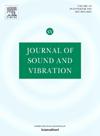Micro-perforated rainbow-trapping silencers with broadband sound dissipation and reduced drag under low-speed grazing flow
IF 4.3
2区 工程技术
Q1 ACOUSTICS
引用次数: 0
Abstract
The aeroacoustic optimization of rainbow trapping silencers (RTS) shielded from a low-speed turbulent flow by a micro-perforated panel (MPP) has been hardly explored in order to achieve simultaneous high broadband dissipation and low friction factor. Direct global optimization from aeroacoustic numerical models is still cumbersome. A cost-efficient hybrid optimization process is proposed based on maximization of the total dissipated power calculated from a Transfer Matrix Model (TMM) under downstream propagation conditions subject to an aerodynamic constraint on the MPP holes pitch and diameter based on RANS-Realizable k – ε parametric study. The TMM is validated against Large Eddy Simulations at global scale on the scattering properties of the MPP-RTS, but also at MPP hole scale, pointing out the key role played by in-hole vortical patterns in the dissipation mechanism and the flow-induced reduction of air mass at the wetted inlet of MPP holes. The hybrid optimization approach shows that a common set of MPP-RTS parameters are able to provide both high dissipation, slow sound and low drag performance in Darcy regime. Aeroacoustic measurements in a low-speed wind tunnel on a hybrid-optimized MPP-RTS prototype corroborate the maximum total dissipation objective and friction factor constraint. Downstream and upstream propagation conditions are found to respectively reduce and enlarge towards low and high frequencies the efficiency range of MPP-RTS whereby high dissipation and attenuation effects are prominent and occur well below that of unshielded RTS.
低速掠流条件下具有宽频散声和减阻特性的微孔彩虹捕获消声器
为了同时实现高宽带耗散和低摩擦因数,采用微孔板(MPP)屏蔽的彩虹捕获消声器(RTS)在低速湍流中的气动声学优化研究很少。直接从气动声学数值模型进行全局优化仍然很麻烦。基于ransr - realizable k - ε参数研究,提出了一种基于传输矩阵模型(TMM)计算的下游传播条件下总耗散功率最大化的混合优化方法。利用大涡模拟在全球尺度上验证了MPP- rts的散射特性,并在MPP孔尺度上验证了TMM,指出了孔内涡旋模式在MPP孔湿润入口耗散机制和气流诱导的气团减少中所起的关键作用。混合优化方法表明,一组通用的MPP-RTS参数可以同时提供高耗散、慢声和低阻力的达西区域性能。在低速风洞中对混合优化后的MPP-RTS原型机进行了气动声学测试,验证了最大总耗散目标和摩擦因数约束。发现下游和上游传播条件分别减小和扩大了MPP-RTS的效率范围,其中高耗散和衰减效应突出,远低于无屏蔽RTS。
本文章由计算机程序翻译,如有差异,请以英文原文为准。
求助全文
约1分钟内获得全文
求助全文
来源期刊

Journal of Sound and Vibration
工程技术-工程:机械
CiteScore
9.10
自引率
10.60%
发文量
551
审稿时长
69 days
期刊介绍:
The Journal of Sound and Vibration (JSV) is an independent journal devoted to the prompt publication of original papers, both theoretical and experimental, that provide new information on any aspect of sound or vibration. There is an emphasis on fundamental work that has potential for practical application.
JSV was founded and operates on the premise that the subject of sound and vibration requires a journal that publishes papers of a high technical standard across the various subdisciplines, thus facilitating awareness of techniques and discoveries in one area that may be applicable in others.
 求助内容:
求助内容: 应助结果提醒方式:
应助结果提醒方式:


